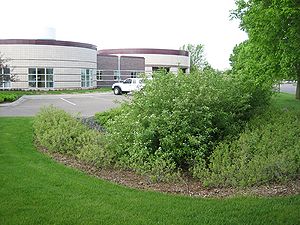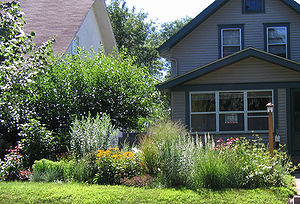
Difference between revisions of "Bioretention"
(Created page with "<div class="center">Overview for bioretention</div> <div class="center">Types of bioretention</div> <div class="center">Design criteria for bioretention</div> <div...") |
m |
||
| (91 intermediate revisions by 3 users not shown) | |||
| Line 1: | Line 1: | ||
| − | < | + | <!--[[File:Review team logo.png|200px|thumb|alt=image for technical team|<font size=3>[[Bioretention technical review team]]</font size>]]--> |
| − | < | + | [[File:mids logo.jpg|300px|right|alt=image of Minimal Impact Design Standards logo]] |
| − | < | + | |
| − | < | + | {{alert|Bioretention practices are commonly called rain gardens|alert-info}} |
| − | < | + | |
| − | + | {{alert|Bioretention practices can be an important tool for retention and detention of stormwater runoff. Because they utilize vegetation, bioretention practices provide additional benefits, including cleaner air, carbon sequestration, improved biological habitat, and aesthetic value.|alert-success}} | |
| − | + | ||
| − | + | [[file:Stillwater rain garden 2.JPG|thumb|300px|alt=photo of a rain garden|<font size=3>A rain garden in a commercial development, Stillwater, Minnesota.</font size>]] | |
| − | + | ||
| − | + | [[File:Native landscaping.jpg|thumb|300px|alt=photo of a rain garden planted with native vegetation|<font size=3>Example of a rain garden planted with native vegetation.</font size>]] | |
| − | + | ||
| − | + | <!-- | |
| − | + | This page introduces sources for the selection of plants for stormwater BMPs, salt tolerance, [[Green roofs|green roofs]], and [[Trees|trees]]. An excellent resource applicable to a wide variety of vegetated BMPs, including bioretention BMPs, is [https://www.pca.state.mn.us/water/plants-stormwater-design Plants for stormwater design] by Shaw and Schmidt (2003). | |
| + | |||
| + | [[file:Residential rain garden.png|thumb|300 px|alt=image of residential rain garden|<font size=3>A residential rain garden in St. Paul.</font size>]] | ||
| + | --> | ||
| + | |||
| + | [[Glossary#B|Bioretention]] is a terrestrial-based (up-land as opposed to wetland) water quality and water quantity control process. Bioretention employs a simplistic, site-integrated design that provides opportunity for runoff infiltration, filtration, storage, and water uptake by vegetation. | ||
| + | |||
| + | Bioretention areas are suitable stormwater treatment practices for all land uses, as long as the contributing drainage area is appropriate for the size of the facility. Common bioretention opportunities include landscaping islands, cul-de-sacs, parking lot margins, commercial setbacks, open space, rooftop drainage and street-scapes (i.e., between the curb and sidewalk). Bioretention, when designed with an underdrain and liner, is also a good design option for treating [[Potential stormwater hotspots|stormwater hotspots]] (PSHs). Bioretention is extremely versatile because of its ability to be incorporated into landscaped areas. The versatility of the practice also allows for bioretention areas to be frequently employed as stormwater retrofits. | ||
| + | |||
| + | <font size=4>[[Acknowledgements for bioretention|Acknowledgements]]</font size> | ||
| + | |||
| + | <u><font size=3>Bioretention articles</font size></u> | ||
| + | *[[Bioretention terminology]] (including types of bioretention) | ||
| + | *[[Overview for bioretention]] | ||
| + | *[[Design criteria for bioretention]] | ||
| + | *[[Construction specifications for bioretention]] | ||
| + | *[[Operation and maintenance of bioretention and other stormwater infiltration practices]] | ||
| + | *[[Operation and maintenance of bioretention and other stormwater infiltration practices - supplemental information]] | ||
| + | **[[Operation and maintenance of bioretention]] - we recommend using the above two pages | ||
| + | *[[Assessing the performance of bioretention]] | ||
| + | *[[Cost-benefit considerations for bioretention]] | ||
| + | *[[Calculating credits for bioretention]] | ||
| + | *[[Green Infrastructure benefits of bioretention]] | ||
| + | *[[Soil amendments to enhance phosphorus sorption]] | ||
| + | *[[Summary of permit requirements for bioretention]] | ||
| + | *[https://stormwater.pca.state.mn.us/index.php?title=Category:Level_3_-_General_information,_reference,_tables,_images,_and_archives/Images/Bioretention_photos Bioretention photos] | ||
| + | *[[Bioretention photo gallery]] | ||
| + | *[https://stormwater.pca.state.mn.us/index.php?title=Category:Level_3_-_General_information,_reference,_tables,_images,_and_archives/Images/Schematic_-_bmps Bioretention schematics] | ||
| + | *[https://stormwater.pca.state.mn.us/index.php?title=Category:Level_3_-_General_information,_reference,_tables,_images,_and_archives/Tables/Bioretention Bioretention tables] | ||
| + | *[[Supporting material for bioretention]] | ||
| + | *[[External resources for bioretention]] | ||
| + | *[[References for bioretention]] | ||
| + | *[[Requirements, recommendations and information for using bioretention with no underdrain BMPs in the MIDS calculator]] | ||
| + | *[[Requirements, recommendations and information for using bioretention with an underdrain BMPs in the MIDS calculator]] | ||
| + | |||
| + | {{alert|bioretention facilities are designed to mimic a site's natural hydrology|alert-success}} | ||
| + | |||
| + | <noinclude> | ||
| + | ==Related pages== | ||
| + | *[[Understanding and interpreting soils and soil boring reports for infiltration BMPs]] | ||
| + | *[[Determining soil infiltration rates]] | ||
| + | |||
| + | [[Category:Level 3 - Best management practices/Structural practices/Bioretention]] | ||
| + | </noinclude> | ||
Latest revision as of 21:04, 22 December 2022
Bioretention is a terrestrial-based (up-land as opposed to wetland) water quality and water quantity control process. Bioretention employs a simplistic, site-integrated design that provides opportunity for runoff infiltration, filtration, storage, and water uptake by vegetation.
Bioretention areas are suitable stormwater treatment practices for all land uses, as long as the contributing drainage area is appropriate for the size of the facility. Common bioretention opportunities include landscaping islands, cul-de-sacs, parking lot margins, commercial setbacks, open space, rooftop drainage and street-scapes (i.e., between the curb and sidewalk). Bioretention, when designed with an underdrain and liner, is also a good design option for treating stormwater hotspots (PSHs). Bioretention is extremely versatile because of its ability to be incorporated into landscaped areas. The versatility of the practice also allows for bioretention areas to be frequently employed as stormwater retrofits.
Bioretention articles
- Bioretention terminology (including types of bioretention)
- Overview for bioretention
- Design criteria for bioretention
- Construction specifications for bioretention
- Operation and maintenance of bioretention and other stormwater infiltration practices
- Operation and maintenance of bioretention and other stormwater infiltration practices - supplemental information
- Operation and maintenance of bioretention - we recommend using the above two pages
- Assessing the performance of bioretention
- Cost-benefit considerations for bioretention
- Calculating credits for bioretention
- Green Infrastructure benefits of bioretention
- Soil amendments to enhance phosphorus sorption
- Summary of permit requirements for bioretention
- Bioretention photos
- Bioretention photo gallery
- Bioretention schematics
- Bioretention tables
- Supporting material for bioretention
- External resources for bioretention
- References for bioretention
- Requirements, recommendations and information for using bioretention with no underdrain BMPs in the MIDS calculator
- Requirements, recommendations and information for using bioretention with an underdrain BMPs in the MIDS calculator
Related pages
This page was last edited on 22 December 2022, at 21:04.


